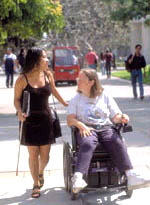 Print this page.
Print this page.
The Future of Robotic Rehabilitation Therapy & Problems That Must Be Resolved
In the 1970's, the goal of assistive robotics was to design prosthesis to replace limbs [16]. The trend in robotics is towards the robots becoming more natural–smaller and more similar to biological systems–but before such intelligent machines can become commonplace.....
Technical Problems
Assuring patient safety is the primary and overriding concern that must be worked out before rehabilitative robots can become more widely used [11].
A more natural human-robot interface for use by people with disabilities to perform everyday tasks needs to be developed. Direct control interfaces are sometimes too physically and cognitively demanding on the user and create real-time problems. Command based systems require an unreasonable recall of commands on the part of the user. Autonomous systems, which lie at the extreme of robot control, have a list of problems all of their own to overcome: incomplete priori knowledge about the environment, insufficient sensory information, and inherent inaccuracy of robotic devices [17].
During the recovery process, even more sensitive and objective measures of motor performance during functional tasks need to be developed [16].
More software for a greater variety of exercises for patients to perform, including functional tasks, needs to be developed [19].
Other Problems to Overcome
Researchers are seeking to understand how the brain reorganizes itself following stroke or spinal cord injury and how mobility and thought help in cortical restructuring [20]. Neurologists are working towards mapping out the brain to find the correlation of exterior stimulation in regrouping. Neurologists and robotics engineers will have to work together in evaluating the effectiveness of robotic therapies; further, breakthroughs in one discipline should not hold up the other.
Studies are needed to compare various robot protocols in order to develop clinically and commercially viable robotic therapy robots. In order to achieve acceptable cost-benefit ratios, complex robotic systems need to be evaluated for clinical effectiveness and elements pared down if necessary [16]. “For explosive growth in the market, major technical and cost breakthroughs are necessary”[11].
Industrial robot standards need to be harmonized with EN/ISO standards for medical uses. The safety standard, EN ISO 10218:1992 regarding robot operations demands “the absence of persons in the safeguarded space during automatic operation.” Manufacturing robots that are deemed safe and overcoming legal obstacles is a factor in availability of robotic rehabilitation to potential users [19].
“Economic pressures on the U.S. health care system are causing individuals with a brain injury to go home sooner and receive less therapy” [21]. Yet, “there is a clear economic incentive to increasing therapy dosage without requiring increased therapist time” [21]. Questions need to be evaluated to prove in monetary terms, “Can we afford not to push more for robotic rehabilitation?”
